TRANSIT AND ON-STREET RAIL
The MUTCD Section 8A.01 refers to LRT as "a mode of metropolitan transportation that employs LRT vehicles (commonly known as light rail vehicles, streetcars, or trolleys) that operate on rails in streets in mixed traffic, and LRT traffic that operates in semi-exclusive rights-of-way, or in exclusive rights-of-way. Grade crossings with LRT can occur at intersections or at midblock locations, including public and private driveways." Traffic control for LRT is determined in part by the type of alignment:
- Exclusive–This type of alignment does not have grade crossings. The alignment is grade-separated or protected by a fence or traffic barrier. Motor vehicles, pedestrians, and bicycles are prohibited within the traveled way. Subways and aerial structures are included within this group. Because the alignment does not have grade crossings, there are no provisions for traffic control devices.
- Semi-exclusive–An alignment where the LRT operates within a separate traveled way or along a street or railroad ROW where motor vehicles, pedestrians, and bicycles have limited access and cross at designated locations only. In a semi-exclusive alignment, LRT vehicles usually have ROW over other roadway users at grade crossings.
- Mixed-use–An alignment where the LRT operates in mixed traffic with all types of road users. This includes streets, transit malls, and pedestrian malls where the traveled way is shared. In a mixed-use alignment, the LRT vehicles or buses do not have ROW over other roadway users at grade crossings and intersections and LRT vehicles are usually controlled with the same devices used by general traffic.
It is important to understand that provisions in Part 8 of the MUTCD are intended to be applicable to both LRT and conventional railroads; therefore, when the phrase "grade crossing" is used by itself without the prefix "highway-rail" or "highway-LRT" it refers to both highway-rail and highway-LRT crossings. Conversely, LRT-specific provisions are indicated as applicable to "Highway-LRT Grade Crossings." (In accordance with FRA requirements,(32) where LRT operates in the same corridor, e.g., "shared corridor" or on the same track as conventional rail, FRA requirements are applicable to both the conventional rail crossings as well as the LRT crossings in that corridor.) The MUTCD does not define the term "streetcar." Although streetcar vehicles and trains resemble LRT, where streetcars operate in "mixed flow" in the same travel lane as other highway vehicles, traffic control treatments and provisions applicable to highway traffic in general are applicable to the streetcar operation. Where a streetcar operates in a semiexclusive alignment, provisions and traffic control treatments applicable to LRT operating in a semi-exclusive alignment should be considered.
The LRT Traffic Control Systems is the overarching term used to describe the combination of devices selected or installed at a specific highway-LRT crossing. According to MUTCD Section 8A.03, there is not a single standard system universally applicable due to the many significant variables to be considered. The selection of traffic control devices and the assignment of priority to LRT at a highway-LRT crossing is jointly determined by the highway agency with jurisdiction, the regulatory agency with statutory authority, if applicable, and the LRT authority. The normal rules of the road and traffic control priority identified in the "Uniform Vehicle Code" govern the order assigned to the movement of vehicles at an intersection unless the local agency determines that it is appropriate to assign a higher priority to LRT.(9)
The LRT-specific MUTCD provisions are provided in Sections 8A.01 (Introduction), 8A.03 (Use of Standard Devices, Systems, and Practices), 8B.05 (STOP and YIELD signs), 8C.03 (Flashing-Light Signals), 8C.05 (Automatic Gates) and 8C.10 (Traffic Control Signals at or Near Highway-LRT Grade Crossings), 8C.11 (Use of Traffic Control Signals for Control of LRT Vehicles), and 8C.13 (Pedestrian and Bicycle Signals). Key requirements are as follows:
- Section 8A.03 requires that Highway-LRT grade crossings in semi-exclusive alignments shall be equipped with a combination of automatic gates and flashing-light signals, or flashing-light signals only, or traffic control signals, unless an engineering study indicates that the use of Crossbuck Assemblies, STOP signs, or YIELD signs alone would be adequate.
- Section 8B.03 and 8B.04 contain provisions regarding the use and placement of Crossbuck signs and Crossbuck Assemblies. Section 8B.05 describes the appropriate conditions for the use of STOP of YIELD signs alone at a highway-LRT grade crossing. Sections 8C.10 and 8C.11 contain provisions regarding the use of traffic control signals at highway-LRT grade crossings.
- Section 8C.05 has various provisions depending upon the alignment, LRT speeds, and traffic conditions which can be summarized as follows:
- Where LRT speeds exceed 35 mph, highway-LRT crossings "should" be equipped with automatic gates and flashing-light signals.
- At LRT crossings "within highway-highway intersections" where LRT speeds do not exceed 35 mph, traffic control signals may be used instead of automatic gates.
- Where LRT speeds exceed 25 mph and a highway-LRT crossing is at a location "other than an intersection," automatic gates and flashing-light signals "may" be installed (but are not required).
- At LRT crossings "other than an intersection" where the roadway is a low-volume street where prevailing speeds do not exceed 25 mph and where LRT speeds do not exceed 25 mph, traffic control signals or flashing-light signals without automatic gates "may" be used.
For additional information, reference the MUTCD (2009) Section 8A.03, Use of Standard Devices, Systems, and Practices at Highway-LRT Crossings.
Control of Motor Vehicle Turning Treatments
Motor vehicles making illegal turns in front of approaching light-rail vehicles (LRV) are one of the most common types of collision for most LRT systems.(33) Moreover, when such a collision occurs, the door of the motor vehicle is the only protection between the driver/passenger and the LRV, which makes turning collisions one of the most severe types of collisions between motor vehicles and LRVs. Traffic control devices that regulate turns are critical to LRT and general traffic safety. Current practice is to provide dedicated turn lanes for traffic turning toward the LRT crossing where practicable with traffic control signal indications for such movements.
Where turning traffic crosses a non-gated, semi-exclusive LRT alignment and is controlled by left-or right-turn arrow signal indications, Transit Cooperative Research Program (TCRP) Report 17 recommends that the LRT agency install an LRV-activated, flashing, internally illuminated warning sign displaying the front view LRV symbol (W10-7) when the LRV approaches.(34) When such a sign is used, the turn arrow signal indication serves as the primary regulatory control device and the flashing, internally illuminated warning sign supplements it, warning motorists of the increased risk associated with violating the turn arrow signal indication. The MUTCD allows use of this sign at LRT crossings controlled by STOP signs or automatic gates.
Where turning traffic crosses a non-gated, semi-exclusive LRT alignment and is controlled by a STOP sign or signal without a turn arrow (such as a permissive left or right turn), TCRP Report 17 recommends that an LRV-activated, internally illuminated "NO LEFT/RIGHT TURN" (R3-2/R3-1) symbol sign be provided to restrict left or right turns when an LRV is approaching (see Figure 46).(34) Because these signs would serve as the primary control devices regulating turning movements, TCRP Report 17 recommends that two signs be provided for each parallel approach. The LRV-activated, internally illuminated sign displaying the legend NO LEFT/RIGHT TURN may be used as an alternate to the active, internally illuminated symbol sign.

Table 6 summarizes the recommended practices for the active, internally illuminated "NO LEFT/RIGHT TURN" symbol sign (regulatory) and the flashing, internally illuminated "TRAIN APPROACHING" sign (warning) for median or side-running LRT alignments where parallel traffic may proceed during LRV movements.
Table 6. Use of Active Internally Illuminated Signs for Parallel Traffic Turning Across LRT Tracks
| Alignment Type | Intersection Traffic Control Device | NO LEFT/RIGHT TURN ACROSS TRACKS Sign | Train Icon Sign for Left/Right Turnsa |
|---|---|---|---|
| Semi-exclusive gated | Stopc | Recommended | May |
| Traffic signal without arrowd | Recommendedb | May | |
| Traffic signal with arrowe | Not recommended | May | |
| Semi-exclusive non-gated | Stopc | Recommended | May |
| Traffic signal without arrowd | Recommendedb | May | |
| Traffic signal with arrowe | Not recommended | Recommended |
- Left-turn signs are for median and side-aligned LRT alignments; right-turn signs are for side-aligned LRT alignments only.
- Alternatively, an all-red phase for motor vehicles and pedestrians may be used in combination with "No Turn On Red" (R10-11a) signs.
- "Stop" refers to a STOP sign-controlled intersection.
- "Without arrow" refers to a signalized intersection at which the turning traffic has no red arrow displayed when an LRV is approaching but has either a steady green ball, a red ball, or a flashing red ball displayed.
- "With arrow" refers to a signalized intersection at which the turning traffic has a red arrow displayed when an LRV is approaching.
When a turn arrow traffic signal indication is used, TCRP Report 17 recommends that an exclusive turn lane be provided.
Source: Adapted from Korve, Hans W., Jose I. Farran, Douglas M. Mansel, et al. Integration of Light Rail Transit into City Streets, Washington, DC, TRCP Report 17, TRB, 1996.
For semi-exclusive alignments, all traffic conflicting with LRV movements at intersections and crossings should be positively controlled through use of turn pockets, traffic signals, and active warning signs.
LRT Bar Signals
The MUTCD Section 8C.11 provides the following guidance for use of LRT signals (refer to Figure 47):
- LRT movements in semi-exclusive alignments at non-gated crossings that are equipped with traffic control signals should be controlled with LRT Bar Signals.
- LRT signals that are used to control LRT movements only should display the signal indications illustrated in MUTCD Figure 8C-3.
- Standard traffic control signal indications may be used instead of LRT signals to control the movement of LRT vehicles (see Section 8C.10).
- Note that Section 4D.27 contains information about the use of LRT signals for the control of exclusive bus movements at "queue jumper lanes" and for the control of exclusive bus rapid transit movements on semi-exclusive or mixed-use alignments.
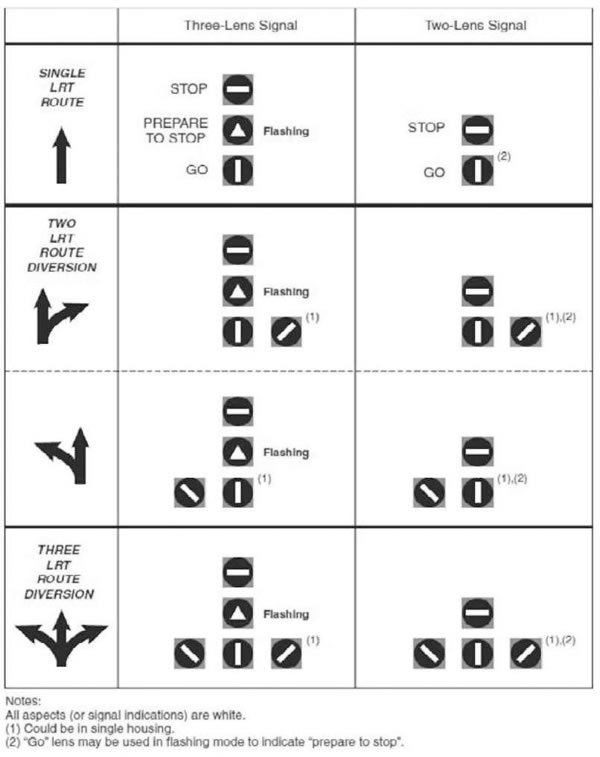
Source: Manual on Uniform Traffic Control Devices, 2009 Edition, Figure 8C-3, Washington, DC, FHWA, 2009.
Pedestrian and Bicycle Signals at LRT Crossings
The MUTCD Section 8C.13 requires use of standard traffic control signal pedestrian signal heads compliant with Section 4E.04 where such heads are used at LRT crossings. Consistent with current practice, the MUTCD indicates flashing-light signals with a Crossbuck sign and audible device should be used where there is inadequate clearing sight distance (refer to sight distance information in Chapter 2), or where LRT speeds exceed 35 mph.
The MUTCD also allows use of the LOOK sign (R15-8) and/or pedestrian gates subject to an engineering study which indicates a flashing-light signal with Crossbuck would not be adequate. In addition, the MUTCD allows use of pedestrian "swing gates" as an option. Common practice includes use of swing gates in conjunction with pedestrian automatic gates where the swing gates can be used to provide a means of egress for users who are within the crossing zone when crossing gates are activated. (Refer to MUTCD Chapter 8D for additional swing gate provisions.)
PEDESTRIANS, BICYCLES, AND ACCESSIBILITY
This section presents material on non-motorized transportation or "active" transportation which is defined by the US Centers for Disease Control and Prevention as "any self-propelled, human-powered mode of transportation, such as walking or bicycling" as well as accessibility considerations and requirements associated with the "Americans with Disabilities Act of 1990" (ADA). PL 101-336, and the "ADA Amendments Act of 2008," PL 110-325."(35) Unless otherwise noted, the term "pedestrian" as used in this section refers to bicycles and other forms on non-motorized transportation in addition to pedestrians themselves.
Non-motorist crossing safety should be considered at all highway-rail crossings, particularly at or near commuter stations and at non-motorist facilities, such as bicycle/walking trails, pedestrian-only facilities, and pedestrian malls. Although collisions between trains and pedestrians occur less often than collisions between trains and motor vehicles, they are more severe. Research Results Digest 84 (36), which studied pedestrian/LRV collisions, cites "risky or inattentive behavior" as a factor in pedestrian collisions and cites various contributing factors taken from the National Transit Database4 which were collaborated by transit agency staff:
- Rushing to catch trains or get across intersections
- Ignoring audible and/or visual warnings at crossings
- Distractions, such as cell phones and headsets
- Not paying attention in transit malls (usually involves little or no injury)
- Intoxication
- Trespassing(36)
These behavioral factors can be exacerbated by the fact that LRVs–commuter trains operating in "push" mode–as well as conventional trains operating in designated Quiet Zones may be nearly silent approaching a crossing. For these reasons, appropriate pedestrian crossing control systems are critical for pedestrian safety.
4 https://www.transit.dot.gov/ntd
It should be noted that injuries and fatalities (whether accidental or intentional as with suicides) also occur due to trespassing within the rail ROW; however, these topics are beyond the scope of this Handbook. Practitioners should consult other resources provided by the FRA, the Federal Transit Administration (FTA), and other sources including Operation Lifesaver Incorporated (OLI) for information and guidance on treatments which complement grade crossing treatments.
Pedestrian safety is enhanced when pathways and sidewalks are designed such that they cross the tracks as close to a right angle as practical. It is desirable that pathways and sidewalks be designed to maintain a relatively consistent horizontal alignment and profile of12 feet from the nearest rail, the distance from the nearest rail to the detectable warning (if present), or the distance from the nearest rail to the stop line (if present), whichever is greater, on each approach to the crossing. Providing a pedestrian refuge area in advance of the stop line or detectable warning surface so pedestrians have a place to wait while rail traffic approaches and occupies the crossing can be beneficial to pedestrian safety. When designing new sidewalk crossings, placing the sidewalk outside of the area occupied by crossing traffic control devices for vehicular traffic is important. This includes making sure that the counterweights and support arms for the automatic gates for vehicular traffic do not obstruct the sidewalk when the gate is fully lowered.
Passive and active devices may be used to supplement highway-related active control devices to improve non-motorist safety at highway-rail crossings. Passive devices include fencing, swing gates, pedestrian barriers, detectable warning surfaces, pavement markings, texturing, refuge areas, and fixed message signs. Active devices include flashers, audible active control devices, automated pedestrian gates, pedestrian signals, variable message signs, and blank-out signs. These devices should be considered at crossings with high pedestrian traffic volumes, high train speeds or frequency, extremely wide crossings, complex highway-rail crossing geometry with complex ROW assignment, school zones, inadequate sight distance; and/or multiple tracks. All pedestrian facilities should be designed to minimize pedestrian crossing time, and devices should be designed to avoid trapping pedestrians between sets of tracks.
Channelization
The behavior of pedestrians crossing railroads is difficult to control. There are a variety of reasons pedestrians may disobey or ignore traffic control devices. Also, pedestrians often seek the shortest path and therefore may not always cross the tracks at the highway or designated pedestrian crossing. Pedestrian movements should be channelized to designated engineered crossing locations which provide warnings and controls designed for pedestrian use. Current practice used by commuter rail and transit extends fencing 50 to 100 feet back from designated pedestrian crossings to direct pedestrians to the crossing. Where fencing is used, the height should be reduced to 3.5 feet maximum within 100 feet of the crossing to avoid restricting sight distance.(31) Alternatives to fencing less likely to impede sight distance include bollards or short posts with chains, or low landscaping.
Accessibility Standards
The ADA gives civil rights protections against discrimination to individuals with disabilities. It affords equal opportunity for individuals with disabilities in public accommodations, employment, transportation, State and local government services, and telecommunications. Titles II and III of the ADA include the enforceable accessibility standards called the 2010 ADA Standards for Accessible Design. The Department of Justice's 2010 ADA Standards include standards for Accessible Routes. The Draft Proposed Right-of-Way Accessibility Guidelines (PROWAG) published by the United States Access Board, which were in rulemaking when this Handbook went to press, address many geometric features pertaining to pedestrian facilities, including the following:
- Minimum widths and clearances
- Accessible routes and pedestrian pathways
- Curb ramps and ramps
- Detectable warning strips
- Protruding objects
These standards are available from the Access Board website at https://www.ada.gov/.(37)
MUTCD Provisions
The MUTCD presents provisions for LRT-pedestrian crossings in Sections 8C.13 and for "pathway" crossings in Section 8D. Pathways are defined in Section 1A.13 of the MUTCD as "a general term denoting a public way for purposes of travel by authorized users outside the traveled way and physically separated from the roadway by an open space or barrier and either within the highway right-of-way or within an independent alignment. Pathways include shared-use paths, but do not include sidewalks." As such, pathways are distinguished from sidewalks which are considered part of the highway crossing. The FRA categorizes pedestrian crossings as either "pathway" or "station." Practitioners should refer to MUTCD Section 8D for both "pathway" and "station" crossing treatments and provisions.
The MUTCD Section 8C.13 includes provisions for pedestrian and bicycle signals at LRT crossings. Although designated for LRT crossings, the guidance can be applied at conventional rail crossings such as those located along sidewalks. It should be noted that 8C.13 requires that pedestrian signal heads where used shall comply with the provisions of MUTCD Section 4E.04. Provisions for "pathway" crossings not associated with sidewalks are found in Section 8D of the MUTCD. However, as noted in 8D.01, many treatments outlined in Section 8D are applicable to crossings along sidewalks.
Current Practices
Current practices and guidance, some of which have been developed from LRT-crossing research, are shown in the following sections with references to MUTCD provisions and illustrative examples of various treatments.
Pedestrian Refuge Areas (Refer to MUTCD Section 8C.13)
- Where adjacent tracks are present, pedestrian movements should be designed to avoid having pedestrians wait between sets of tracks.
- Where a track crossing is immediately adjacent to a road in a semi-exclusive alignment, a pedestrian refuge area or island between the tracks and the road should be provided to permit pedestrians to stand clear of the tracks while waiting to cross the roadway. If there is insufficient area for a pedestrian refuge area or island between the tracks and the road, additional pedestrian signal heads, signing, and detectors (see MUTCD Section 4E.08) or flashing-light signals should be installed based on engineering judgement.
Pathway Crossing Signs and Markings (Refer to MUTCD Section 8D.03)
- Pathway grade crossing signs shall be standard in shape, legend, and color.
- The minimum mounting height for post-mounted signs adjacent to pathways and sidewalks shall be 4 feet, measured vertically from the bottom edge of the sign to the elevation of the near edge of the pathway or sidewalk surface.
- Where used at a pathway grade crossing, the traffic control device or its support shall be at least 2 feet laterally from the near edge of the pathway. Where traffic control devices are placed over a pathway or sidewalk, the vertical clearance shall be at least 8 feet for pathways.
Stop Lines and Edge Lines and Dynamic Envelope Markings (Refer to MUTCD Sections 8D.04, 3B.06 and 8B.29)
- If used at pathway crossings, the stop line should be a transverse line at the point where a pathway user is to stop. The stop line should be placed at least 2 feet farther from the nearest rail than the gate, counterweight flashing-light signal or Crossbuck assembly (if any of these are present) is placed, and at least 12 feet from the nearest rail.
- Edge lines (see Section 3B.06) may be used on approach to and across tracks to delineate the designated pathway user route.
- Refer to MUTCD Section 8B.29 for use of dynamic envelope markings. In an LRT/pedestrian mall, the dynamic envelope may be delineated in its entirety.(34)
Recommended Practices for Stop Lines and Detectable Warnings
Detectable warning surfaces mark boundaries between pedestrian and vehicular ways where there is no raised curb. Detectable warning surfaces contrast visually with adjacent walking surfaces, either light-on-dark, or dark-on-light. Detectable warning surfaces are required by 49 CFR 37, Appendix A, 406.8 and by the ADA where curb ramps are constructed at the junction of sidewalks and the roadway, for marked and unmarked crosswalks. Proposed guidelines developed by the United States Access Board (R304.2.3) will require use of detectable warnings at all grade crossings whether along sidewalks or pathways located so that the edge nearest the rail crossing is 6 feet minimum and 15 feet maximum from the centerline of the nearest rail.(37)The March 2014 update by the Access Board provides recent information on the design and placement of detectable warning surfaces.(38)
- A stop line should be provided at a pathway crossing if the surface where the marking is to be applied can retain the application of the marking
- Detectable warnings should be used at pathway crossings where pedestrian travel is permitted and at sidewalk crossings and should extend across the full width of the pathway or sidewalk
- Detectable warnings should be placed immediately in advance of the pathway or sidewalk stop line (if present)
- The near edge of the detectable warnings should be located no less than 12 feet from the nearest rail and be at least 2 feet in depth
- Where the distance between the center line of two tracks exceeds 38 feet, additional detectable warnings, designating the limits of a pedestrian refuge area, should be used at sidewalk or pathway crossings
Crossbuck Assemblies and Swing Gates (Refer to MUTCD 8D.05)
The MUTCD indicates a Crossbuck Assembly shall be installed on each approach to a pedestrian crossing except at station crossings and sidewalk crossings located within 25 feet of the traveled way. The MUTCD also contains provisions for use of swing gates which shall be designed to open away from the tracks and automatically return to the closed position. Use of swing gates should consider the crossing user's ability to detect the presence of approaching rail traffic. (ADA Accessibility Guidelines for Buildings and Facilities [ADAAG] contains information regarding spring hinges and gate opening forces.)
Active Traffic Control Devices (Refer to MUTCD 8D.06)
The MUTCD requires that flashing-light signals, where used at a pathway crossing, shall be provided for each direction and that a bell or other audible warning device shall be provided. The flashing red lights shall be aligned horizontally. Reduced-size lenses may be used at a lower height at pathway crossings, however, the units shall have a diameter of at least 4 inches and a minimum mounting height of 4 feet except where installed between tracks, in which case a minimum mounting height shall be 1 foot.
Current practice considers the following:
- Flashing-light signals, bell or audible warning device may be omitted at pathway or sidewalk crossings that are located within 25 feet of an active warning device at a crossing that is equipped with those devices.
- Additional pairs of flashing-light units, bell or audible warning devices may be installed on the active traffic control devices at a crossing from the back side of those devices.
- Pedestrian signal heads as described in Chapter 4E (of the MUTCD) utilizing Upraised Hand and Walking Person symbols should not be used at a pathway or sidewalk crossing except where a traffic control signal is used to control both rail and highway vehicles.
Pedestrian Automatic Gates (Refer to MUTCD 8D.06)
The MUTCD recommends that automatic gates used at pathway crossings should be a minimum of 2.5 feet and a maximum of 4 feet above the walkway, however, where a vehicular gate extends across a sidewalk, the location, placement and height prescribed for vehicular gates shall be used (see Section 8C.04.).
Current practice considers the following:
- When an automatic gate is used at a sidewalk crossing, a separate mechanism should be provided for the sidewalk gate, instead of a supplemental or auxiliary gate arm installed as a part of the same mechanism.
- If used at a pathway or sidewalk crossing, automatic gate arms should be provided with a minimum of one light as shown in MUTCD Figure 8C.6. This light should be continuously illuminated whenever the warning system is active.
- If used, additional lights on the automatic gate arm should be installed in pairs and flashed alternately in unison with other flashing-light units (see MUTCD Figures 8C.5 and 8C.6.).
- Where automatic pedestrian gates are installed across pathway or sidewalk crossings, an emergency escape route should be available to provide egress away from the track area when the gates are activated.
- An emergency exit route can be provided by use of a swing gate in combination with a pedestrian automatic gate. In this circumstance, the swing gate should be signed as an "Emergency Exit" on the track side and provided with a "DO NOT ENTER" (R5-1) sign on the side facing away from the tracks.
- If used at a pathway or sidewalk crossings, the gate configuration, which might include a combination of automatic pedestrian gates and swing gates, should provide for full-width coverage of the pathway or sidewalk on each approach to the crossing.
ILLUSTRATIVE EXAMPLES OF PEDESTRIAN TREATMENTS
This section provides examples of pedestrian treatments including diagrams shown in the MUTCD and photographs of applications. For additional examples of pedestrian treatments, refer to the FRA reports "Compilation of Pedestrian Safety Devices in Use at Grade Crossings"(39) and "Guidance on Pedestrian Safety at or Near Passenger Stations".(40)
Pathway Crossing Signing and Markings for Bicyclists and Skaters
Crossings which serve higher-speed users such as bicyclists and skaters should use a combination of treatments including advance warning signs and pavement markings along with a Crossbuck Assembly and optional LOOK (R15-8) sign as shown in Figure 48.
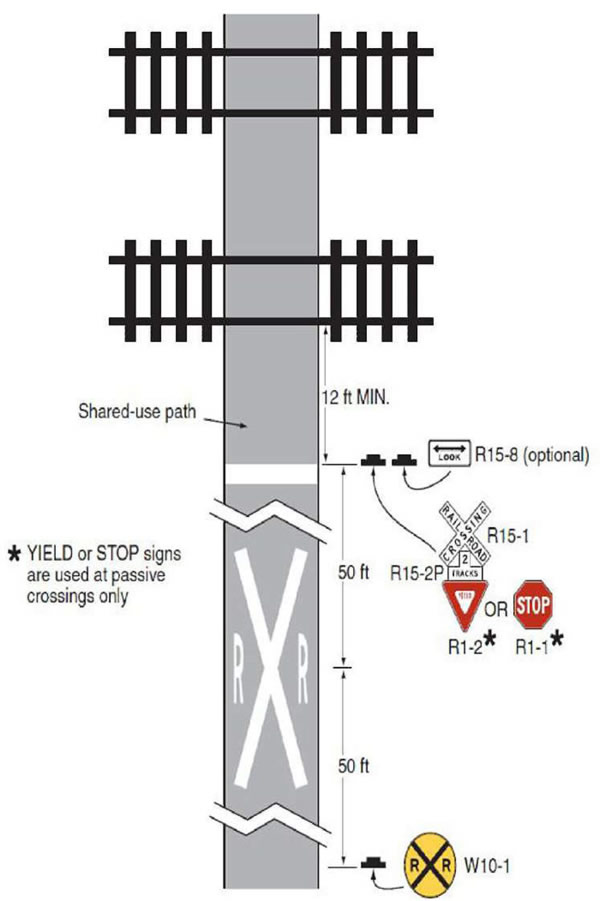
Source: Manual on Uniform Traffic Control Devices, 2009 Edition, Figure 8D-I, Washington, DC, FHWA, 2009.
Dynamic Envelope Markings
As shown in Figure 49, ADA-compliant tactile warning strips have been used to delineate the dynamic envelope continuously through locations where pedestrians may cross the trackway. Figure 50 shows a treatment which uses contrasting pavement to delineate the dynamic envelope through a crosswalk.
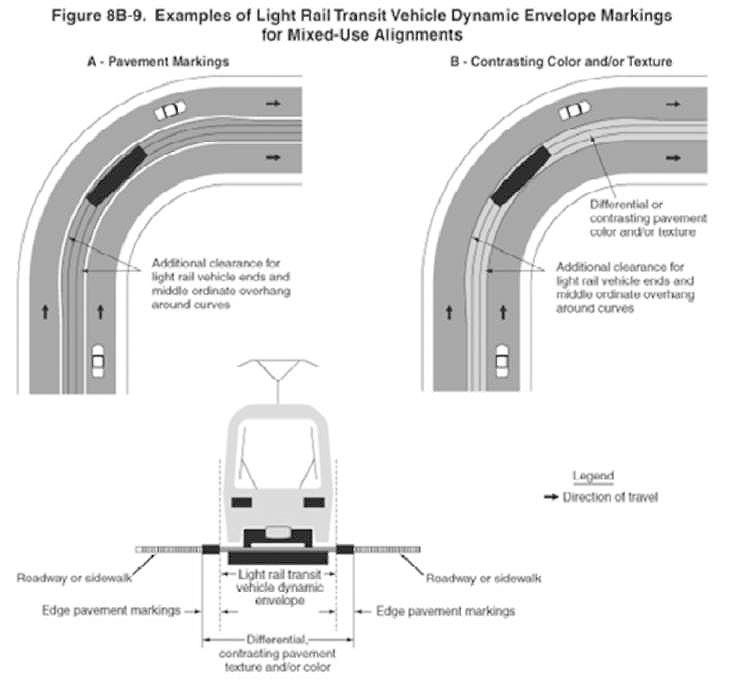

Source: Google Earth V 7.1.7.2602. (September 6, 2016). Morrison St near 12th Ave, Portland, Oregon, USA.45°31'14.06"N, 122°41'01.87"W, Eye alt eye level. DirectX2016. Google Earth Pro. [January 30, 2019].
Pedestrian Barriers
Pedestrian barriers may be placed in an offset pattern to create a "maze" which forces pedestrians to turn and look both ways approaching a sidewalk crossing, especially in tight urban spaces where there is no fenced-in ROW, such as a pedestrian crossing at a street intersection. These barriers can also incorporate a pedestrian refuge zone between the trackway and an adjacent roadway. Figure 51 and Figure 52 show a diagram from the MUTCD as well as an in-situ application from Calgary, Alberta.

Source: Manual on Uniform Traffic Control Devices, 2009 Edition, Section 8C.13 Figure 8C-9, Washington, DC, FHWA, 2009.

Source: FHWA.
Pedestrian barriers are less effective where trains operate in both directions in single or double-track territory because pedestrians may be looking the wrong way in some instances. Where fencing is installed to direct path or sidewalk users to the pathway or sidewalk crossing, it is desirable that this fencing be connected to any continuous existing or new fencing or channelization that has been installed parallel to the track(s) to discourage pedestrians from circumventing the crossing. Pedestrian barriers should be designed to permit the passage of wheelchairs and power-assisted mobility devices, and if bicycles are permitted, to permit the passage of dismounted bicyclist with tandem bicycles or bicycles with trailers.
Z-crossing Channelization
Similar in function to a maze created with pedestrian barriers, a "Z-crossing" is designed to turn pedestrians toward approaching trains, forcing them to look in the direction of oncoming rail vehicles. Figure 53 and Figure 54 show a diagram from the MUTCD as well as an application from Portland, Oregon. Z-crossing channelization may be used at pathway crossings where pedestrians are likely to run unimpeded across the tracks, such as isolated, midblock, pedestrian-only crossings, particularly where there is good stopping sight distance and pedestrian volumes are low and active devices are not required. Standard configuration Z-crossings are not suitable for single- or double-track locations where trains operate in both directions on a regular basis. The angled crossing configuration can be adapted by extending the length of the diagonal zone so users face both directions while traversing the crossing but angled crossings are more difficult for wheelchairs and bicycles to navigate.

Application in Portland, Oregon
Source: Manual on Uniform Traffic Control Devices, 2009 Edition, Section 8C.13 Figure 8C-10, Washington, DC, FHWA, 2009.
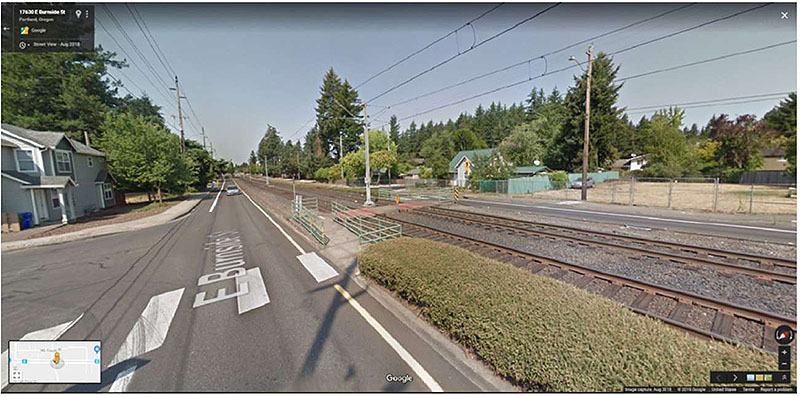
Source: Google Earth V 7.1.7.2602. (September 6, 2016). Burnside near E 176th Ave, Portland, Oregon, USA.451°31'19.06"N, 122°28'54.69"W, Eye alt eye level. DirectX 2016. Google Earth Pro. [July 18, 2018].
Swing Gates
The swing gate (sometimes used in conjunction with flashing-lights and bells) alerts pedestrians to the presence of tracks and causes them to pause before crossing. This restriction of movement encourages pedestrians to assess the crossings' surroundings and approaching rail traffic. The swing gate requires pedestrians to pull the gate to enter the crossing and push the gate to exit the protected track area; therefore, a pedestrian cannot physically cross the track area without pulling and opening the gate. Figure 55 shows how swing gates may be used to control a pedestrian crossing within a station area for movement between platforms.

Source: Manual on Uniform Traffic Control Devices, 2009 Edition, Section 8C.13 Figure 8C-8, Washington, DC, FHWA, 2009.
Alternatively, a swing gate may be used as an exit gate from a crossing area which is controlled by pedestrian automatic gates. When used in this manner, the gate should be provided with a sign facing users within the crossing that it is provided as an "emergency exit" as well as with a "DO NOT ENTER" (R5-1) sign facing users approaching the crossing. Figure 56 shows an in-situ example.
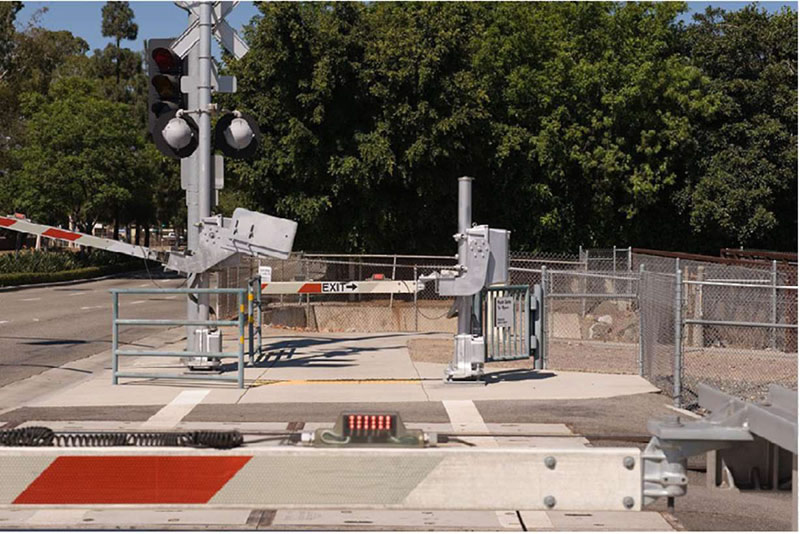
Source: Brian Gilleran, Federal Railroad Administration.
Flashing-Light Signals
At pedestrian crossings where engineering study indicates the need to provide active warning, the flashing-light signal assembly can be provided. Flashing-light signals should be used in conjunction with a crossing bell or audible device and may be used either at pathway crossings as shown in Figure 57, Option A, or in quadrants opposite road gates as shown in Option B. When the red lenses of the flashing-light signal are flashing alternately and the audible device of the flashing-light signal is active, the pedestrian is required to remain clear of the tracks (Uniform Vehicle Code, Section 11-513).(9) A Crossbuck Assembly with the standard Crossbuck sign (R15-1) and, where there is more than one track, an auxiliary inverted T-shaped sign indicating the number of tracks (R15-2) should be used in conjunction with the flashing-light device.
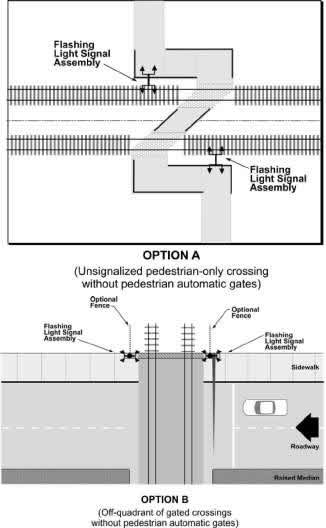
Source: Korve, Hans W., Jose I. Farran, Douglas M. Mansel, et al. Integration of Light Rail Transit into City Streets, Transit Cooperative Research Report 17, Transportation Research Board, Washington, DC, 1996.
Pedestrian Automatic Gates
Pedestrian automatic gates are the same as standard automatic crossing gates except the gate arms are shorter. When activated by an approaching train, the automatic gates are used to physically prevent pedestrians from crossing the tracks. The "TCRP Report 17," which evaluated LRT crossings, recommends this type of gate be used in areas where pedestrian risk of a collision as determined by engineering study is medium to high (for example, where stopping sight distance is inadequate and pedestrian volume is significant).(34)
The preferred method is to provide pedestrian automatic gates in all four quadrants, either using separate pedestrian gates or with a combination of pedestrian gates and vehicular gates extending across the sidewalk as shown in Figure 58. Where ROW conditions permit, the vehicle automatic gate may be located behind the sidewalk on the back side away from the curb, so that the arm will extend across the sidewalk, blocking the pedestrian way (see top illustration in Figure 58). Longer and lighter gate arms make this installation feasible; however, experience suggests a maximum gate arm length of 38 feet for practical operation and maintenance. At crossings requiring the gate arm to be longer than 38 feet, a second automatic gate could be placed in the roadway median, or a separate pedestrian gate could be used as shown in the bottom illustration of Figure 58. Note that the effective coverage is less than 38 feet due to setback requirements and the size of the gate mechanism.
It should be noted that pedestrians can be trapped behind the crossing gate when there is full closure. In principle, the minimum setback of 12 feet provides a refuge zone between the gate and dynamic envelope. However, to avoid potential panic, current practice uses a separate swing gate, as a designated emergency exit, where crossing gates would completely enclose the crossing (see Figure 56).
Crossing Gate Skirt
Crossing gate "skirts" which may be constructed by attaching a horizontal hanging bar to the gate arm have been shown to be effective at reducing the likelihood that pedestrians will violate a lowered crossing gate.(41) Crossing gate skirts were installed along the Dallas LRT system at sidewalk approaches to an elementary school to reduce the likelihood that children would duck under the gates while walking to school. Figure 59 and Figure 60 show a gate deployed at the Lynn Haven Avenue crossing in Dallas, Texas.

Source: Manual on Uniform Traffic Control Devices, 2009 Edition, Section 8C.13 Figure 8C-7, Washington, DC: FHWA, 2009.

Source: Gabree, S & Chase, Stephanie & daSilva, Marco. Effect of Gate Skirts on Pedestrian Behavior at Highway-Rail Grade Crossings, FRA, Washington, DC, 2013.

Source: Brent Ogden.
